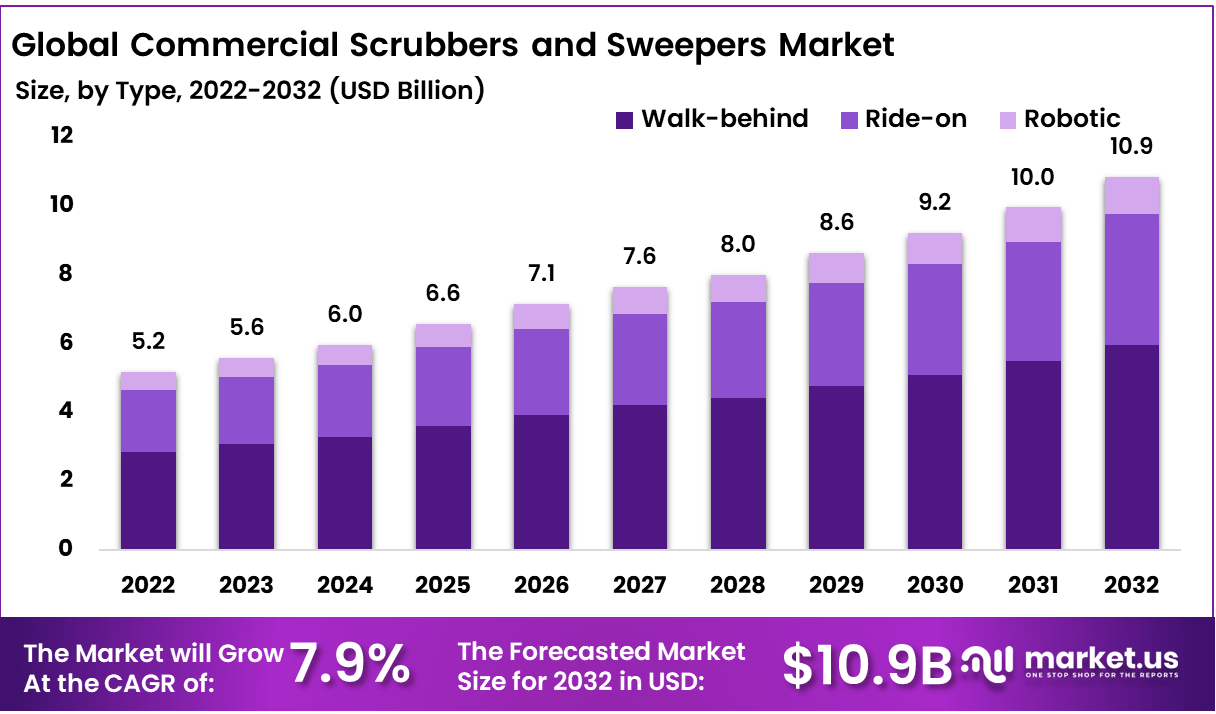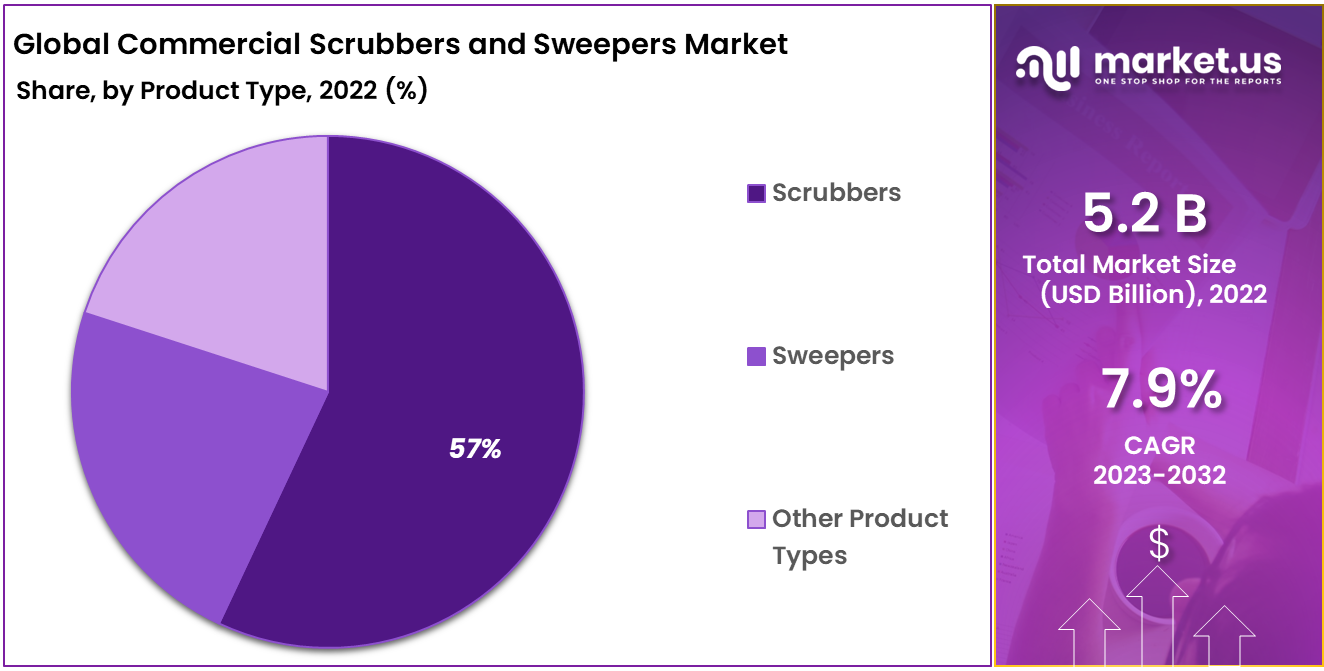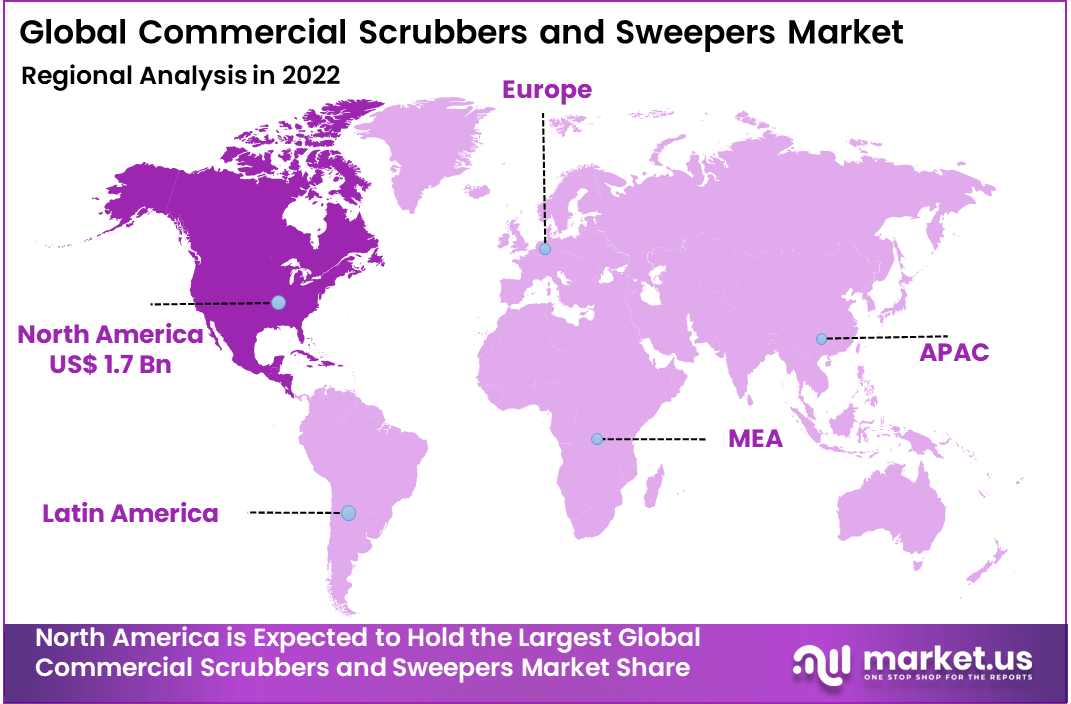Global Commercial Scrubbers and Sweepers Market By Type (Walk-behind, Ride-on, and Robotic), By Product Type (Scrubbers, Sweepers, and Other Product Types), By Power Source (Electricity and Batteries) By End-User, By Region and Companies - Industry Segment Outlook, Market Assessment, Competition Scenario, Trends, and Forecast 2023-2032
- Published date: Sep 2023
- Report ID: 106047
- Number of Pages: 371
- Format:
- keyboard_arrow_up
Quick Navigation
Report Overview
The Global Commercial Scrubbers and Sweepers Market size is expected to be worth around USD 10.9 Billion by 2032 from USD 5.2 Billion in 2022, growing at a CAGR of 7.90% during the forecast period from 2023 to 2032.
Commercial scrubbers and sweepers play an indispensable role in maintaining cleanliness across various industries. These powerful machines are specifically designed to efficiently remove dirt, debris, and stains from various surfaces such as floors or carpets.
Electronic cleaning methods provide numerous advantages over traditional methods, including increased productivity and reduced labor costs, as well as superior cleaning quality. Commercial scrubbers and sweepers are increasingly sought-after due to rising awareness of their importance for maintaining clean environments within workplaces, retail spaces, and public facilities.
Industries increasingly prioritize increasing operational efficiencies while offering their customers and employees pleasant experiences; consequently, demand for these cleaning solutions continues to soar.

Actual Numbers Might Vary in the Final Report
Driving Factors
Increasing Focus On Hygiene and Sanitation
The surge in hygiene and sanitation awareness, particularly in settings like malls, airports, hospitals, and industrial facilities, has spurred a heightened demand for effective cleaning solutions such as scrubbers and sweepers.
These machines play a pivotal role in upholding cleaner and more hygienic environments, a paramount concern amplified by the ongoing COVID-19 pandemic. Furthermore, the rapid trajectory of industrialization and urbanization has fueled the expansion of commercial spaces, encompassing factories, warehouses, and logistics centers.
These dynamic environments necessitate consistent and proficient cleaning to bolster operational efficiency and sustain cleanliness standards. As a result, the demand for commercial scrubbers and sweepers has intensified, serving as crucial tools to manage the rigorous cleaning requirements in these evolving and expanding spaces.
Scrubbers and sweepers are particularly effective in maintaining different types of flooring surfaces, including concrete, tiles, and carpets. The emphasis on preserving and prolonging the life of these surfaces contributes to the demand for cleaning equipment.
Restraining Factors
High Initial Costs and Operational & Maintenance Costs
One significant restraining factor is the initial high cost associated with purchasing and deploying commercial scrubbers and sweepers. These advanced cleaning machines come with sophisticated technologies and features that enhance their cleaning efficiency, but these innovations often contribute to higher price points.
This cost factor can deter budget-conscious businesses from adopting these solutions, especially smaller enterprises that may find it challenging to allocate resources for such capital-intensive investments. Another restraining factor is the need for skilled operators to effectively operate and maintain these commercial cleaning machines. While automation and technological advancements have made these devices more user-friendly, there is still a requirement for trained personnel who can handle the equipment properly and ensure its optimal performance.
The shortage of skilled operators in some regions can hinder the widespread adoption of commercial scrubbers and sweepers. Environmental concerns also pose a restraint to the market’s growth. While these machines offer efficiency benefits in terms of cleaning and reducing the need for chemical cleaning agents, they often require power sources, which might include electricity or fuel.
The carbon footprint associated with the operation of these machines, especially those powered by non-renewable energy sources, raises environmental considerations that businesses and regulatory bodies must address.
Growth Opportunities
The global commercial scrubber and sweeper market offers tremendous growth potential. These machines play a vital role in maintaining cleanliness and hygiene across multiple industries, such as manufacturing, retail, healthcare, and hospitality. With increasing emphasis on maintaining clean and safe working environments and stringent hygiene regulations, demand for commercial scrubbers and sweepers has skyrocketed.
Businesses increasingly rely on automated cleaning solutions as part of their efforts to enhance operational efficiency and lower labor costs, with commercial scrubbers and sweepers offering time- and labor-saving alternatives to traditional manual methods of cleaning. Integrating advanced technologies, like robotics, IoT sensors, and artificial intelligence, into machines further extends their capabilities, enabling intelligent navigation, data analysis, and remote monitoring.
Commercial scrubbers and sweepers not only contribute to cleaning duties, but they’re also helping the planet through sustainability goals. Many are designed with eco-friendly features such as water recycling capabilities, energy-efficient components, and reduced chemical usage.
Latest Trends
The global commercial scrubbers and sweepers market has witnessed significant trends that are shaping the industry’s landscape in recent times. One of the most prominent trends is the growing emphasis on sustainability and eco-friendliness.
As environmental concerns continue to gain traction, businesses are increasingly seeking cleaning solutions that minimize their carbon footprint and reduce the use of harmful chemicals. Manufacturers in the commercial scrubbers and sweepers market are responding by developing more energy-efficient and water-saving equipment that aligns with these sustainability goals.
Moreover, technological advancements have brought about a wave of innovation in the industry. Automation and smart technologies are playing a crucial role in enhancing the efficiency and effectiveness of commercial scrubbers and sweepers. The integration of sensors, artificial intelligence, and IoT capabilities allows these machines to operate autonomously, optimizing cleaning processes and reducing the need for human intervention.
This not only improves cleaning outcomes but also leads to operational cost savings for businesses. Furthermore, the rental and subscription models are gaining popularity in the commercial scrubbers and sweepers market.
Many businesses are opting to lease cleaning equipment rather than making substantial upfront investments in purchasing them. This trend is driven by the desire to avoid high initial costs, benefit from regular maintenance and upgrades, and have access to the latest cleaning technologies without long-term commitments.
By Type Analysis
The Walk-Behind Type is Expected to Dominate This Market
Based on type, the market for commercial scrubbers and sweepers is classified into walk-behind, ride-on, and robotic. The walk-behind commercial scrubbers and sweepers segment is dominating the market share with 55%. The dominance of the walk-behind type in the market for commercial scrubbers and sweepers can be attributed to several key factors that have contributed to its widespread adoption and preference among businesses.
Firstly, walk-behind scrubbers and sweepers offer a high level of maneuverability and flexibility, making them well-suited for navigating through tight spaces, confined areas, and obstacles. This makes them particularly effective for cleaning tasks in commercial environments with limited room to move around.
Secondly, walk-behind scrubbers and sweepers are often more cost-effective compared to their ride-on and robotic counterparts. They typically have lower upfront costs and maintenance expenses, making them an attractive option for businesses looking to achieve efficient cleaning solutions without a substantial financial investment.
Additionally, walk-behind scrubbers and sweepers are relatively easy to operate and require minimal training, which enhances their accessibility and usability across various industries. This simplicity in operation ensures that businesses can quickly integrate these machines into their cleaning routines without extensive training periods.
By Product Type Analysis
Scrubbers Product Type Dominate This Market
Based on product type, the market for commercial scrubbers and sweepers is classified into scrubbers, sweepers, and other product types. scrubbers segment is dominating the market share with 57%. Owing to their advanced cleaning capabilities and versatility across a range of industries. Scrubbers offer a more comprehensive and efficient cleaning process compared to sweepers, as they not only remove debris and dirt but also provide a thorough scrubbing action that tackles stubborn stains, grime, and even grease.
This makes them particularly well-suited for environments that require deep cleaning, such as manufacturing facilities, healthcare institutions, and commercial kitchens. Furthermore, the demand for heightened hygiene standards in various sectors has driven the preference for scrubbers, as they are capable of sanitizing and disinfecting surfaces effectively. This has become especially crucial in light of global health concerns and the need to maintain clean and safe environments.
The adaptability of scrubbers to different floor types, including tiles, concrete, and even delicate surfaces, has also contributed to their dominance. They often come with adjustable settings and brush types that cater to specific cleaning needs, making them a versatile solution for businesses with diverse flooring requirements.
By Power Source Analysis
Battery Power Source is Expected to Dominate This Market
Based on power sources, the market for commercial scrubbers and sweepers is classified into electricity and batteries. Battery-powered commercial scrubbers and sweepers have proven extremely popular among businesses for various reasons, particularly their mobility and flexibility. Battery-powered machines allow businesses to move around more freely thanks to portable machines that offer unparalleled maneuverability and versatility.
Cordless robots offer greater mobility, allowing them to navigate spaces efficiently without the restrictions posed by power outlets or cords. This feature makes them particularly suitable for large areas or multi-level facilities where access to power outlets may be limited.
Second, battery-powered scrubbers and sweepers are known for having lower noise levels compared to their electric counterparts, making them particularly suitable for businesses that need cleaning during operational hours or in environments sensitive to noise such as hospitals, hotels, or retail spaces where interruption from noise could harm daily activities. Their quiet operation ensures minimal disturbance of daily routines.
By End-User Analysis
Contract Cleaning End-User Dominate in This Market
Based on the end-user, the market for commercial scrubbers and sweepers is classified into contract cleaning manufacturing, transportation & travel, healthcare, education, government, chemical &pharmaceutical, and other end-users.
The dominance of contract cleaning as an end-user segment in the market for commercial scrubbers and sweepers can be attributed to several compelling factors that highlight the industry’s significance and widespread adoption. Contract cleaning companies play a pivotal role in maintaining cleanliness and hygiene across various commercial spaces, and their preference for scrubbers and sweepers is based on practical considerations.
Firstly, contract cleaning companies often service a diverse range of clients and facilities, including office buildings, retail spaces, hotels, and industrial sites. Scrubbers and sweepers provide them with versatile cleaning solutions that can effectively address different types of surfaces and cleaning requirements. This versatility reduces the need for multiple specialized cleaning equipment, streamlining their operations and reducing costs.
Secondly, the efficiency and speed offered by scrubbers and sweepers align with the time-sensitive nature of contract cleaning services. These machines cover larger areas in a shorter span of time compared to manual cleaning methods, allowing contract cleaning companies to meet tight cleaning schedules and deliver consistent results to their clients.
Moreover, the professional image that contract cleaning companies strive to maintain is enhanced by the use of advanced cleaning equipment. Scrubbers and sweepers showcase their commitment to quality and modern cleaning practices, contributing to client satisfaction and retention.

Commercial Scrubbers and Sweepers Market Key Segmentation:
Based on Type
- Walk-behind
- Ride-on
- Robotic
Based on Product Type
- Scrubbers
- Sweepers
- Other Product Types
Based on the Power Source
- Electricity
- Batteries
Based on End-User
- Contract Cleaning
- Manufacturing
- Transportation & Travel
- Healthcare
- Education
- Government
- Chemical & Pharmaceutical
- Other End-Users
Regional Analysis
North America dominated the global market in terms of revenue share in 2022, with more than 34%. One of the key drivers is the advanced technological landscape present in North America, fostering innovation and the development of cutting-edge cleaning equipment. This has led to the creation of highly efficient and customizable scrubbers and sweepers that cater to diverse commercial needs.
Furthermore, the robust industrial infrastructure in North America, spanning various sectors such as manufacturing, hospitality, and healthcare, has significantly boosted the demand for effective cleaning solutions. The emphasis on maintaining high hygiene standards in these industries has driven the adoption of sophisticated scrubbers and sweepers to ensure cleanliness, safety, and compliance with regulations.
In addition, the strongest presence of established manufacturers, along with a competitive business environment, has facilitated the growth of the commercial cleaning equipment market in North America. This has encouraged the development of a vast range of products to cater to different market segments and customer preferences.
Moreover, the region’s focus on sustainability and environmental responsibility has prompted the integration of eco-friendly features in commercial scrubbers and sweepers. This aligns with the increasing global awareness of environmental concerns and regulations, giving North American manufacturers an edge in catering to environmentally conscious customers.

Key Regions and Countries Covered in this Report:
- North America
- The US
- Canada
- Europe
- Germany
- France
- The UK
- Spain
- Italy
- Russia & CIS
- Rest of Europe
- APAC
- China
- Japan
- South Korea
- India
- ASEAN
- Rest of APAC
- Latin America
- Brazil
- Mexico
- Rest of Latin America
- Middle East & Africa
- GCC
- South Africa
- United Arab Emirates
Global Commercial Scrubbers and Sweepers Market is extremely dynamic. All major companies are trying to increase their market share. Kärcher, Power-Flite, and Factory Cat are major market players across the globe.
Market Key Players:
- Nilfisk
- Tennant
- Kärcher
- Hako Group
- Factory Cat
- Power-Flite
- Numatic
- Amano
- TASKI
- Bucher Industries
- IPC
- Cleanfix
- Other Key Players
Recent Developments:
In 2023, Amano, Introduced the AMR 1200, an autonomous cleaning robot designed for large-scale commercial spaces, showcasing their advancements in robotics.
- In 2023, TASKI, rolled out the IntelliTrail system, enabling real-time monitoring and tracking of cleaning machines for enhanced efficiency and maintenance.
- In 2023, Bucher Industries, Launched the CityCat 5030, an innovative street sweeper with advanced cleaning technology and environmental features.
Report Scope:
Report Features Description Market Value (2022) US$ 5.2 Bn Forecast Revenue (2032) US$ 10.9 Bn CAGR (2023-2032) 7.9 % Base Year for Estimation 2022 Historic Period 2016-2022 Forecast Period 2023-2032 Report Coverage Revenue Forecast, Market Dynamics, COVID-19 Impact, Competitive Landscape, Recent Developments Segments Covered By Type-Walk-behind, Ride-on, and Robotic; By Product Type-Scrubbers, Sweepers, and Other Product Types; By Power Source-Electricity, and Batteries; By End-User- Contract Cleaning, Manufacturing, Transportation & Travel, Healthcare, Education, Government, Chemical & Pharmaceutical, and Other End-Users; Regional Analysis North America: The US and Canada; Europe: Germany, France, The UK, Italy, Spain, Russia & CIS, and the Rest of Europe; APAC: China, Japan, South Korea, India, ASEAN, and the Rest of APAC; Latin America: Brazil, Mexico, and Rest of Latin America; Middle East & Africa: GCC, South Africa, United Arab Emirates, and Rest of Middle East & Africa. Competitive Landscape Nilfisk, Tennant, Kärcher, Hako Group, Factory Cat, Power-Flite, Numatic, Amano, TASKI, Bucher Industries, IPC, Cleanfix, and Other Key Players Customization Scope Customization for segments, region/country-level will be provided. Moreover, additional customization can be done based on the requirements. Purchase Options We have three licenses to opt for Single User License, Multi-User License (Up to 5 Users), Corporate Use License (Unlimited User and Printable PDF) Frequently Asked Questions (FAQ)
What is the Commercial Scrubbers and Sweepers Market Size Estimated During the Forecast Period?The Global Commercial Scrubbers and Sweepers Market size was from USD 5.2 Billion in 2022, growing at a CAGR of 7.90%.
What is the Commercial Scrubbers and Sweepers Market CAGR Estimated During the Forecast Period 2023-2032?The Global Commercial Scrubbers and Sweepers Market size is expected to grow at a CAGR of 7.90% during the forecast period from 2023 to 2032.
What is the Commercial Scrubbers and Sweepers Market Size Estimated During the Forecast Period?The Global Commercial Scrubbers and Sweepers Market size is expected to be worth around USD 10.9 Billion by 2032 during the forecast period.
 Commercial Scrubbers and Sweepers MarketPublished date: Sep 2023add_shopping_cartBuy Now get_appDownload Sample
Commercial Scrubbers and Sweepers MarketPublished date: Sep 2023add_shopping_cartBuy Now get_appDownload Sample - Nilfisk
- Tennant
- Kärcher
- Hako Group
- Factory Cat
- Power-Flite
- Numatic
- Amano
- TASKI
- Bucher Industries
- IPC
- Cleanfix
- Other Key Players
- settingsSettings
Our Clients
| Single User $4,599 $3,499 USD / per unit save 24% | Multi User $5,999 $4,299 USD / per unit save 28% | Corporate User $7,299 $4,999 USD / per unit save 32% | |
|---|---|---|---|
| e-Access | |||
| Report Library Access | |||
| Data Set (Excel) | |||
| Company Profile Library Access | |||
| Interactive Dashboard | |||
| Free Custumization | No | up to 10 hrs work | up to 30 hrs work |
| Accessibility | 1 User | 2-5 User | Unlimited |
| Analyst Support | up to 20 hrs | up to 40 hrs | up to 50 hrs |
| Benefit | Up to 20% off on next purchase | Up to 25% off on next purchase | Up to 30% off on next purchase |
| Buy Now ($ 3,499) | Buy Now ($ 4,299) | Buy Now ($ 4,999) |












